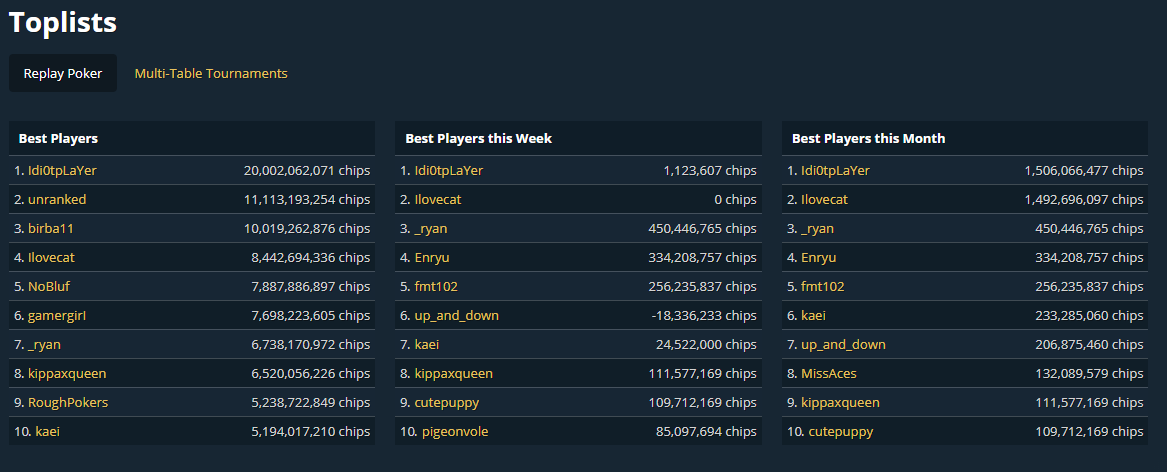How To Read Omaha Low Hands
- How Do You Read Low Hands In Omaha
- Omaha Low Hand Chart
- How To Read Omaha Low Hands
- How To Read Omaha Low Hands Game
- How To Read Omaha Low Hands Club
- How To Read Omaha Low Hands Bridge
Best Starting Hands in Omaha Hi Lo
To qualify for a low hand, the highest card in the low must be no higher than an 8 - hence the name Omaha 8/b - 'Omaha Eight or Better'. So if you have A4678 as your lowest 5 unpaired cards, you. The rules of Omaha hi-lo is usually played with a 'qualifier' for the low hand, meaning all of the cards making up a low hand have to be ranked eight or lower. That's where the 'split-8-or-better'. Low hands in Omaha/8 are ranked ‘top down’, from the highest card in the hand. For example is lower than. This is an example of a “7 low” versus an “8 low”. If the highest card is equal in rank then the next highest card is used to determined the lowest hand. As with the high hand in Omaha, the low hand must include 2 cards from the player's hand and 3 from the board. When there are more than 3 low cards on the board, 'live'. How to Recognize Winning Omaha Poker Starting Hands. The secret to winning in Omaha poker lies in knowing your Omaha poker starting hands. A 52 card deck can produce 5, 277 card combinations using four cards, excluding the combinations of suited cards. So you are either dealt a playable hand with Omaha poker starting hands or a losing hand.

Omaha and Omaha Hi Lo is a much more complicated game then Hold’em simply because you have a wider range of starting hands seen by players due to the additional cards and combinations players can make. If you’ve never played Omaha and not quite sure what we’re referring to you can read our “How to Play Omaha Guide” which will help you with the basics of the game including format.
Since Omaha and Omaha Hi Lo use four hole cards, it’s absolutely critical that you understand the starting hand requirements in both versions. Making poor decisions on which hands to play and which hands to fold will ultimately cost you your bankroll. Although you’ll find plenty of beginners do end up falling for some of the more common omaha myths when choosing their starting hands.
Below you will find general outline to the starting hand requirements in Omaha Hi Lo. Omaha Hi Lo allows you to play for both the hi and low pot and because of this the starting hand requirements in Omaha 8 vary significantly from Omaha Hi since the goal is to be able to play for and win both pots. The starting hands below are dependent on situation, although you may not be able to bluff your way through this game, you can pick up a few additional big blinds through position and restricting your starting hands. Remember two things – the game is made up by strong hands and you need to play for both pots if you plan on coming out ahead.
Premium Starting Hands in Omaha High-Lo
The best starting hands in Omaha Hi Lo include:
How Do You Read Low Hands In Omaha
1. A-A-2-x
2. A-A-3-x
3. A-2-3-x
4. A-2-4-x
5. A-2-x-x
6. A-3-4-x
7. A-A-x-x
While the chart above gives you a general outline of the best starting hands in Omaha Hi Lo, you do need to realize that it is still quite broad as the ‘x’ represents nearly any other card. A suited hand is significantly stronger than a non-suited hand even if they both fall in the same category. Suppose you have the option to play A-A-Q-K rainbow or A-A-2-K suited. The obvious choice of hand would be the later since your able to play for high and low, while giving you a chance at a flush, full house, or straight for hi hands. A tip to keep in mind when determining your hand strength in Omaha Hi Lo using the chart above is that the majority of cards 5 – 9 are essentially worthless. They can be used to pick up a few blinds when in position or playing against a loose table.
Ten of the Best Starting Hands in Omaha High-Low
These hands are considered the top hands in Omaha Hi Lo:
1. A-A-2-3 Double-suited
2. A-A-2-4 Double-suited
3. A-A-2-3 Suited
4. A-A-2-5 Double-suited
5. A-A-2-4 Suited
6. A-A-3-4 Double-suited
7. A-A-2-3 Non-suited
8. A-A-2-2 Double-suited
9. A-A-3-5 Double-suited
10. A-A-2-6 Double-suited
Playable Starting Hands in Omaha High-Low
Below is a summary of hands that are playable starting hands in Omaha Hi Lo
A-A-2-x
A-A-3-x
A-A-4-5
A-2-3-x
A-2-K-K
A-2-Q-Q
A-2-J-J
A-3-4-5
A-A-x-x
A-2-K-Q
A-2-K-J
A-2-x-x (suited Ace)
A-3-K-K
A-3-4-x
2-3-4-5 (This hand is dependent on the Ace hitting the flop. If the flop doesn’t show an Ace you should fold)
J-Q-K-A
T-J-Q-K
K-K-Q-J
Q-J-T-9
2-3-4-x (Another hand that depends on the Ace. If no Ace hits the flop, fold the hand on first bet).
Omaha Low Hand Chart
The high-low split pot version of Omaha is a fun and exciting game, which we will refer to as Omaha/8. It is typically played as a fixed-limit game, but the pot-limit variety (known by the abbreviation PLO/8) is also popular, particularly online. The format, betting structure, and requirement to use two cards from your initial four hole cards, in conjunction with three cards from the board, is all the same as Omaha high but coupled with the addition of the best high and best low hands splitting the pot.

In our lesson on how to play Omaha we outlined that one major difference between Omaha and hold’em was the number of potential hands vying for the pot. In Omaha/8 that number remains constant as each hand still has six possibilities but now some of them are vying for the low end and others for the high. What this translates to is an action packed game with numerous bets and raises and large pots.
Omaha/8 Showdown Rules
Omaha/8 is a split pot game, which means that unless someone scoops the pot it will be split. There are two ways to scoop the entire pot. The first is to have both the best high and low hands. The other way is to possess the best high hand when no hand qualifies for the low.
The High Hand
The high hand in Omaha/8 is the identical to a winning hand in Omaha high. If there is no qualified low hand then the best high hand will win the pot.
How To Read Omaha Low Hands
Qualifying Low Hand
The rules for a qualifying low hand are as follows:
- Players may use any five cards in their hand for the low
- A low hand is five unpaired cards, no higher than an eight
- Aces are low for the low hand (and high for the high hand)
- Flushes and straights do not negatively impact the low hand
Ranking Low Hands
Low hands in Omaha/8 are ranked ‘top down’, from the highest card in the hand. For example is lower than . This is an example of a “7 low” versus an “8 low”.
If the highest card is equal in rank then the next highest card is used to determined the lowest hand. This means that is lower than because the second highest card among the five is lower. If the second highest card was the same then it would go to the third, fourth, and fifth card respectively. If players share the same low cards then the low half of the pot is split.
The best possible low hand in Omaha/8 is A-2-3-4-5, known as a ‘wheel’. Remember that low hands that are straights and flushes do not disqualify it from being low but, in fact, make it a two way hand and a candidate to scoop. While a Royal flush and a five high straight, called a wheel, would represent the best high and best low hands, the hand you really want at the showdown is a five high straight flush to scoop the pot with the best high and low hands.
How To Read Omaha Low Hands Game
Omaha/8 Hand Examples
The basic rules are the same as Omaha high, in that you must use two of your hole cards with three on the board.
In the above example a low hand is not possible because the board doesn’t contain three cards that are eight or lower. Only the best high hand will win. The nuts for this board would be someone holding Jack-Queen for the straight. With (which is an excellent starting hand in Omaha/8) you would use along with the on the board to make a high-hand of one pair.
Here is a hand that would qualify for both the high and the low:
In the above example the board contains three card no higher than an eight; the . The hole cards in this example are very strong. In Omaha/8 you can use any two of your cards for the low and any two for the high-hand. The can be used for the nut high hand (flush) and can be used for the nut low ( A-2-3-7-8). This is a prime candidate for scooping the pot.
How To Read Omaha Low Hands Club
If you’re unsure how to work out low hands, which can be confusing at first, then don’t worry. The key is to count backwards from the highest low card first. As mentioned, the best low hand is A-2-3-4-5 which is a five-low hand, which when counting backwards would obviously be 5-4-3-2-A. The next best low hand would be a six-low of 6-4-3-2-A, followed by 6-5-3-2-A, then 6-5-4-2-A, then 6-5-4-3-A and so on. The highest card is counted first and if there’s a tie the next highest low card is counted.
The split pot rule makes it a very different game to Omaha-high. But it’s important to stress that Omaha/8 is not a game of splits. Whilst the best high hand will win half the pot and the best low hand will win the other half; scooping the entire pot is the true object of this poker game.
How To Read Omaha Low Hands Bridge
This game seems to have polarized poker fans in so far as they either love it or have a disdain for it. I like to call those who love it Omaholics and you should be careful, for if you are just getting started in this addictive form of poker, you may well join their ranks.
Related Lessons
By Tom 'TIME' Leonard
Tom has been writing about poker since 1994 and has played across the USA for over 40 years, playing every game in almost every card room in Atlantic City, California and Las Vegas.
Related Lessons
